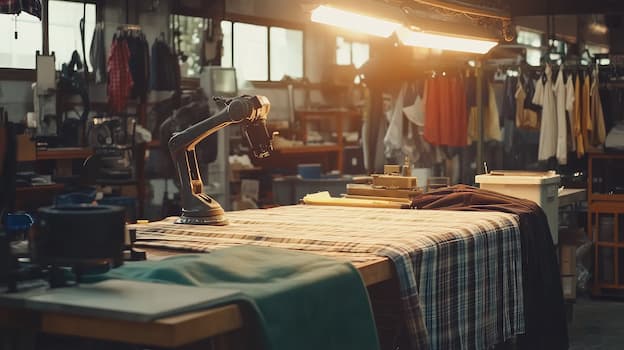Today’s fashion industry would be virtually unrecognizable to trailblazers like Coco Chanel and Christian Dior. After being blown away by trending styles, they’d be stunned at how consumers shop and how companies get their products out the door. The industry moves at break-neck speed, and brands must manage their supply chains and meet consumer demands with state-of-the-art Fashion Logistics at the heart of their operation.
Companies have relied on automation in their distribution centers for years. It speeds up the flow of materials, reduces the physical strain on workers, and cuts down on errors. However, innovations like AI-powered robots, warehouse management software, and automated storage and retrieval systems are changing the game.
Creating an omnichannel logistics system is no longer a dream for fashion companies. Automation doesn’t just make it possible; it makes it easy.
Consumer Demands Dominating the Fashion Industry
The modern consumer plays an active role in shaping the fashion industry. Shoppers expect a lot from brands, and companies must deliver or risk losing business to the competition.
These expectations influence how brands operate, from how they source materials to customer service.
A Personalized Digital Experience
Online shopping has evolved rapidly. Consumers now expect their go-to brands to anticipate their needs. Features like customized recommendations, virtual fitting rooms, personalized pricing, and location-based product offerings allow shoppers to get exactly what they want.
Consumers expect a seamless check-out experience and simple customer support for returns and exchanges. AI chatbots drive this functionality, improving customer satisfaction and loyalty.
Diversity
One size fits all doesn’t cut it in the fashion industry anymore. Consumers want product diversity across the board. This includes:
- Clothing for all body types
- A wide range of sizes
- Age, gender, and race inclusivity in products
- Innovative and diverse designs
Fashion brands that want to stay relevant must accommodate these needs, often expanding product lines to meet customer demand.
Sustainable Practices
Consumers (especially young ones) prioritize environmentalism and ethical business practices when buying. They’re looking for fashion companies that use sustainable materials to produce durable clothes at reasonable prices.
Many people also consider how a company operates before they do business with them. Fashion companies have responded by adopting eco-friendly production and distribution operations.
Speedy Delivery
Fashion brands must streamline their distribution process to meet growing delivery demands. Consumers expect a product to arrive within one to three days after an online purchase. This is shrinking, with same-day delivery becoming more common.
Logistic Obstacles That Can Wear Out Fashion Companies
The fashion market is projected to reach approximately $880 billion in total revenue in 2025. Companies need to examine every aspect of their material sourcing, production line, and goods-to-person process to meet this demand and cater to consumer expectations.
Supply chain issues are some of the most challenging obstacles for fashion brands. Disruptions due to global conflicts, economic fluctuations, and shipping delays turn supply chain management into a guessing game. Companies must form partnerships with multiple suppliers, use tracking technology, and analyze demand forecasts to maintain consistency.
In addition to supply chain difficulties, fashion companies face other logistic challenges, including:
- Inventory management complications due to sudden shifts in trends
- Fluctuation shipping costs
- Rising labor and operational costs
- Managing high return levels
- Facilitating an omnichannel customer experience
Fashion brands that want to overcome these obstacles are turning to automation. There are now automated systems for every step in the material flow of goods through a facility, from inbound goods receipt to product shipping.
Automated Solutions for Industry Challenges
Accommodating online shoppers and brick-and-mortar locations requires a well-oiled fulfillment center with omni-channel capabilities. Innovative ecommerce logistics help brands reduce delivery times, and a seamless warehouse operation supports high demand.
A Smooth Inbound Process
Receiving goods and filtering them into a distribution center can be labor-intensive. This is where products enter a company’s inventory, which must be precise.
Robotic depalletizing systems take the workload off employees by removing goods from shipping pallets and placing them onto automated conveyors. This speeds up the inbound process and reduces the risk of workplace injury.
Depalletizing robots also scan goods into the facility’s inventory, reducing the chance of errors. The items are then automatically sent to the appropriate destination.
Smart Storage and Retrieval
Fashion distribution centers that handle large volumes often run into space issues. Multi-level storage systems eliminate this problem and allow fast and accurate picking.
Automated retrieval robots move through the storage isles and pick up goods when they’re ready to be shipped. They also deliver items to the appropriate spot for storage. In addition to saving space and speeding up the picking process, this automated solution supports accurate inventory management.
Efficient Picking and Packing
Many fashion distribution centers use manual picking and packing stations to prepare orders for shipping. Automated systems make this step in the fulfillment process quick and easy. Conveyors deliver cartons or totes to the correct ergonomic picking station, where workers pull the order and send it off to be packed.
Once the order arrives at the packing station, robotic arms equipped with sensors place the order in a packing box or bag. The order is automatically scanned and labeled for delivery. This offers another level of quality control by assuring the item is shipped to the right customer and logged in the inventory system.
Warehouse Management Software
Distribution facilities relying on automation use state-of-the-art warehouse management software to oversee the operation. This technology syncs with automated systems and acts as the control center of the warehouse.
Warehouse management software provides valuable data that allows companies to lower operational costs, adapt to seasonal spikes, and improve the overall efficiency of the fulfillment process. Data can also be used to reduce waste and work toward a more energy-efficient process.
Market Resilience With Custom-Tailored Automation Systems
No two fashion companies are precisely the same. Each brand has a different product, target customer, and mission. However, they all have one thing in common––they’re part of an ever-changing industry that requires scalable logistics.
Fashion trends come and go quickly, spikes in demand can be sudden, and supply chain disruptions can come out of nowhere. Tailored automation is the key to success In such a fast-paced market landscape. It allows companies to scale when needed without rethinking their entire warehousing and distribution process.
Many fashion brands have embraced scalable logistics automation to add flexibility to their distribution process. A great example is C-LOG, a supply chain specialist that handles distribution for Groupe Beaumanior, a leading French fashion company. C-LOG worked with TGW Logistics, a leader in warehouse automation, to optimize its Fulfillment Center so it could handle the high volume of online orders. They used automated picking stations and a shuttle warehouse to increase productivity and shorten lead times.
Companies can also use automation to create a flexible environment that can react to dips in demand. In these cases, AI-driven robots that transport items across a facility can be removed from the operation to reduce energy costs during slow periods. Other technology, such as automated sorting robots and conveyor systems, can be easily modified depending on market demand.
Automated Tools for Successful Fashion Logistics
Regardless of the fulfillment requirements, automation can transform logistics systems so fashion companies can meet their customer’s needs and work toward their brand mission. Automated technology likely isn’t on shoppers’ minds, but it’s the tool that brings the latest fashion trends to their doorsteps.
Table of Contents

